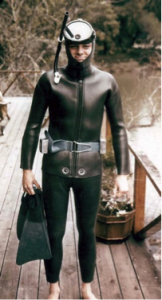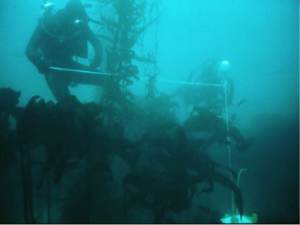by Mike Foster (14 October 2015)

Scientific diving has been an integral part of MLML since 1968 when the first dive class was taught at the Labs during summer session through San Francisco State. Eight students were certified. The program continued under SFS supervision with the diving course taught by MLML graduate students who were certified scuba instructors. The first resident diving officer was Tommy Thompson, hired as the faculty phycologist but also to assume responsibilities for the dive program and liaison with the growing Sea Grant Program. A State funded MLML staff position for dive officer did not exist until the early 1980s so faculty members who were interested and were instructors served as dive officers. Tommy, through Sea Grant, upgraded the program by acquiring dive equipment and support for a subtidal ecology class. He left the faculty in 1976 to become the area Sea Grant Marine Advisor.

This left an opening for a phycologist and dive officer that I gladly applied to fill. The Labs also hired Ann Hurley as co-dive officer and invertebrate ecologist. I was an inactive NAUI scuba instructor at the time, and reactivation required attending a NAUI Instructor class and doing a check out dive with an active instructor. The evaluation ranks as two of the most unpleasant dives I’ve ever had – drops to the mud at 80’ off the Labs to check on a caging experiment with grad students Larry Hulberg and Cheryl Hannan (now Zimmer) – foggy and choppy on the surface, cold and murky on the bottom – and no kelp. But I passed with an increased appreciation for Benthic Bub field work.
Neither Ann nor I were enthused about teaching the dive class, and relied on a dedicated group of MLML grad students and certified scuba instructors, including Larry Hulberg, Steve Pace and Kathy Casson, who were more than willing to teach the class. This worked well for all, and started the tradition of MLML financing instructor certification for students willing to teach the class or serve as assistants. Gary Ichikawa, Bob vanWagenen and John Heine were among those who became instructors as a result. John became full-time dive officer after MLML lobbied successfully to make it a staff position.
Dive facilities were relatively primitive – the compressor and dive locker were located in front of the outdoor aquaria in an area that had been the covered car park for the Beaudette Foundation. When I arrived the State ‘dive truck’ was a rusty, beat up International carry-all with divers using their own cars as needed. The first dive boat for the subtidal class was an old, salvaged black raft powered by a 15 horse outboard, later augmented by a donated Avon dingy towed behind the raft. The unisex shower, shared with volley ball players, was a cinder block structure outside the then seminar room with a wooden pallet on the floor. No doubt everyone who used the shower would have contracted some foot disease if they had to stand in the gunk beneath the pallet.

None of that mattered much: with Labs support MLMLers could learn to dive, get underwater, have fun, and do interesting research. The core of the dive program has always been student enthusiasm and willingness to help each other, supervised by diving officers whose main concern is making it as easy as possible to get underwater safely and efficiently.
Future blogs will include "Scientific Diving at MLML: the middle years" by John Heine, and one on the most current years by Diana Steller.

